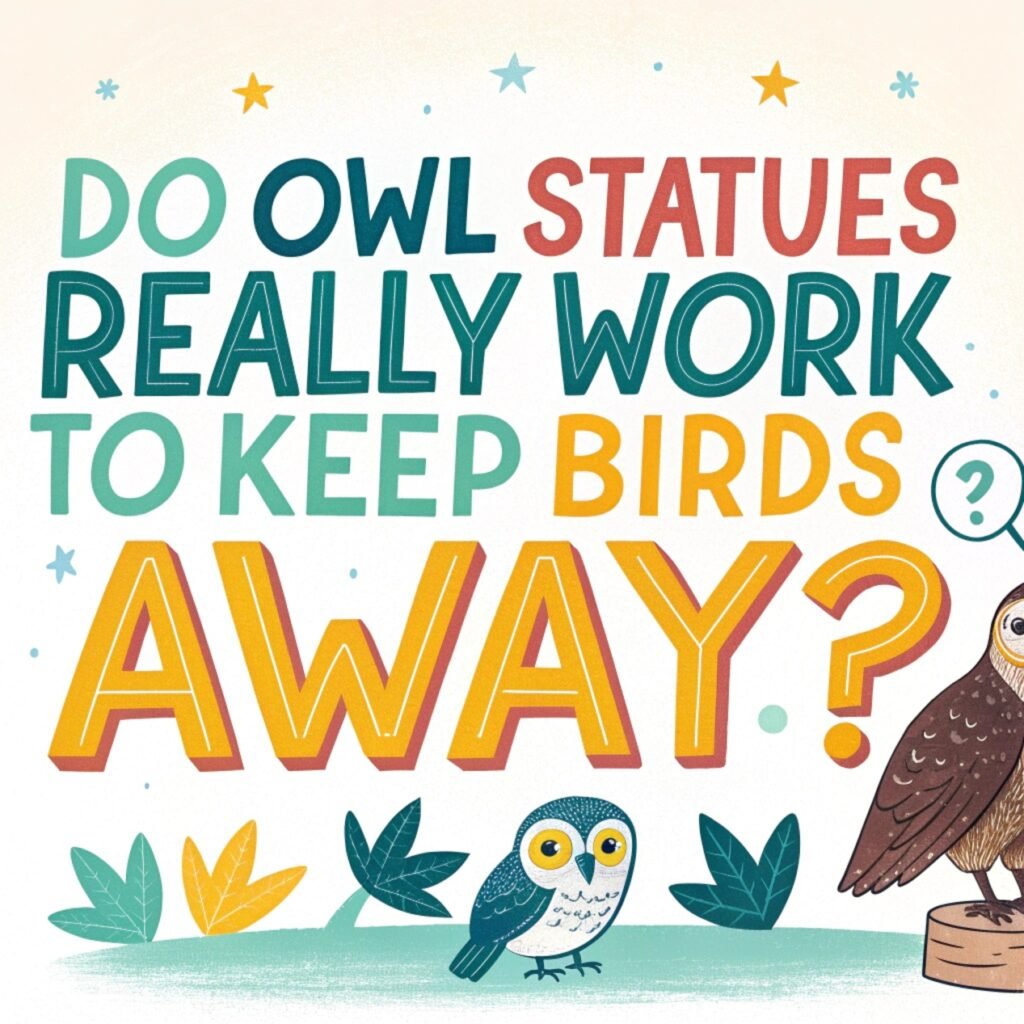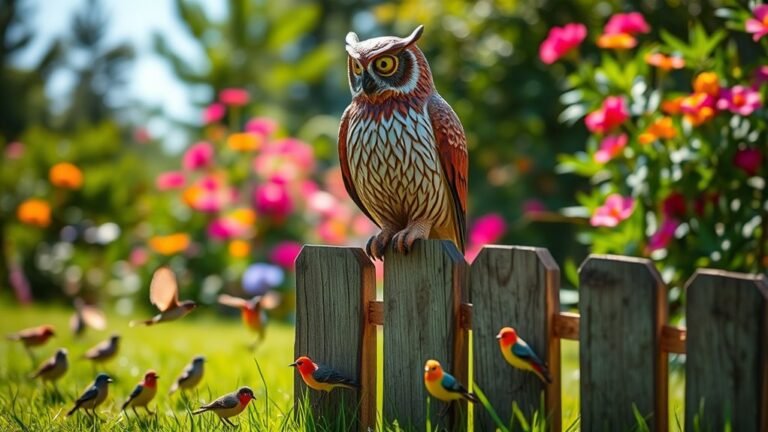Do Owl Statues Really Work to Keep Birds Away? Effectiveness of Decoy Predators
As gardeners, farmers, and property owners seek humane ways to manage bird populations, owl decoys have emerged as a popular solution.
These silent sentinels stand watch over gardens, crops, and buildings, promising to ward off pesky birds with their imposing presence.
This comprehensive exploration delves into the science, psychology, and real-world experiences behind owl decoys as bird deterrents.

Key Takeaways:
- Initial Impact: Owl decoys often have a strong immediate effect, causing a noticeable decrease in bird activity when first introduced.
- Short-Term Success: Scientific studies indicate that owl decoys can be effective for a limited time, typically ranging from a few days to a few weeks.
- Habituation Challenge: Birds are intelligent and adaptable, often becoming accustomed to static decoys over time, diminishing their long-term effectiveness.
- Realism Matters: The more realistic the decoy, including size, color, and details, the more likely it is to be effective in deterring birds.
- Strategic Placement: Positioning owl decoys in natural, elevated locations enhances their believability and effectiveness.
- Movement is Key: Decoys with moving parts or those that are regularly relocated tend to maintain their deterrent effect for longer periods.
- Species Specificity: Owl decoys are more effective against smaller bird species that are natural prey for owls, and less so for larger birds or non-prey species.
- Integrated Approach: Using owl decoys as part of a broader pest management strategy, rather than as a standalone solution, yields better results.
- Ethical Considerations: While non-lethal, decoys may cause stress to birds and potentially disrupt local ecosystems, requiring thoughtful implementation.
- Best Practices: Regular relocation, combining with other deterrent methods, and using high-quality decoys can significantly improve their effectiveness.
- Limitations: Owl decoys are not a permanent solution and may lose effectiveness more quickly in areas with high bird populations or where birds are accustomed to human activity.
Understanding these key points will help you make an informed decision about whether owl decoys are the right choice for your bird control needs and how to use them most effectively if you decide to incorporate them into your strategy.
The Concept Behind Owl Decoys as Bird Deterrents
Owl decoys have long been used as a method to deter unwanted birds from gardens, farms, and other areas.
The concept is based on the natural predator-prey relationship between owls and smaller birds. Owls are formidable predators, known for their silent flight and powerful hunting abilities.
Their presence in an area typically causes smaller birds to flee or avoid the location altogether.
This natural behavior is what people attempt to exploit when using owl statues as bird deterrents.
The idea is that by placing a realistic-looking owl statue in a strategic location, it will create the illusion of a predator’s presence, thereby discouraging other birds from entering or nesting in that area.
Many homeowners and gardeners have turned to this method as a non-lethal and seemingly simple solution to bird problems.
The appeal lies in its passive nature and the fact that it doesn’t require constant human intervention once set up.
However, the effectiveness of this method is a subject of debate among experts and users alike, with varying reports of success and failure.
Scientific Studies on the Effectiveness of Owl Decoys

Several scientific studies have been conducted to evaluate the effectiveness of owl decoys in deterring birds.
One notable study was carried out at Linfield College in Oregon, which concluded that fake owls were indeed effective as bird deterrents, but only for a limited time.
The researchers found that the deterrent effect was strongest immediately after the introduction of the owl decoy, but it diminished over time as birds became accustomed to its presence.
This study highlighted the importance of understanding the temporary nature of the decoy’s effectiveness.
Another research project conducted by Cornell University specifically looked at the impact of plastic owls on woodpeckers.
Their findings aligned with the Linfield College study, indicating that while plastic owls did initially deter woodpeckers, the effect only lasted for a few days.
These studies suggest that while owl decoys can be effective in the short term, their long-term usefulness as a bird control method may be limited without additional strategies.
The Initial Impact: How Birds React to Owl Decoys
When an owl decoy is first introduced to an area, it often has an immediate and noticeable effect on bird behavior.
Birds are naturally wary of predators, and the sudden appearance of what appears to be a large, threatening owl can cause significant alarm.
This initial reaction typically manifests as a sharp decrease in bird activity in the immediate vicinity of the decoy.
Birds may avoid landing near the statue, alter their flight paths to give it a wide berth, or even vocalize alarm calls to warn others of the perceived threat.
The effectiveness during this initial period can be quite dramatic. Gardeners and property owners often report a sudden absence of pest birds that were previously causing problems.
This immediate impact is what leads many people to believe in the efficacy of owl decoys as a bird control method.
However, it’s important to note that this initial reaction is just the first phase of the birds’ response to the decoy, and their behavior often changes over time.
The Limitations of Static Decoys

While owl decoys can be initially effective, their static nature presents significant limitations. Birds are intelligent creatures with keen observational skills.
Over time, they begin to notice that the owl statue never moves, never hunts, and poses no real threat.
This realization leads to a phenomenon known as habituation, where birds gradually become accustomed to the presence of the decoy and cease to view it as a threat.
The process of habituation can occur relatively quickly, sometimes within a matter of days or weeks.
Once birds recognize that the owl statue is harmless, they may even begin to use it as a perch or nesting site, completely negating its intended purpose.
This limitation is one of the primary reasons why owl decoys often fail as a long-term solution for bird control.
To be truly effective, a bird deterrent needs to present a dynamic and unpredictable threat, which static decoys simply cannot provide.
Factors Affecting the Effectiveness of Owl Decoys
Several factors can influence how effective an owl decoy is at deterring birds. The realism of the decoy plays a crucial role.
More lifelike statues, with detailed features and natural coloring, tend to be more effective than simplistic or cartoonish representations.
The size of the decoy is also important; it should be proportionate to a real owl to be convincing.
Additionally, the placement of the decoy can significantly impact its effectiveness. Positioning it in a natural-looking location, such as on a branch or roof edge, can make it more believable to birds.
The type of birds you’re trying to deter also affects the decoy’s success. Some species are more easily fooled by statues than others.
For instance, studies have shown that black-capped chickadees are more readily deterred by owl decoys compared to red-breasted nuthatches.
The local bird population’s prior experience with real owls can also influence their reaction to decoys. In areas where owls are common predators, birds may be more cautious and thus more likely to be deterred by a realistic statue.
Comparing Owl Decoys to Other Bird Deterrent Methods
When evaluating the effectiveness of owl decoys, it’s useful to compare them to other common bird deterrent methods.
Visual deterrents like reflective tape or scare balloons often have similar limitations to owl decoys – they may work initially but lose effectiveness over time.
Auditory deterrents, such as ultrasonic devices or recorded predator calls, can be more effective as they provide a dynamic stimulus, but they too can lead to habituation and may disturb humans and pets.
Physical barriers like netting or spikes are generally more reliable for long-term bird control, as they physically prevent birds from accessing certain areas.
However, these methods can be unsightly and may not be suitable for all situations. Chemical repellents can be effective but raise environmental and safety concerns.
In comparison, owl decoys offer a non-toxic, visually unobtrusive option, albeit with limited long-term effectiveness.
Strategies to Enhance the Effectiveness of Owl Decoys
To maximize the effectiveness of owl decoys and overcome some of their limitations, several strategies can be employed.
One of the most important tactics is to regularly move the decoy to different locations. This movement helps to prevent habituation by creating the illusion of an active predator.
Some people recommend moving the decoy every few days or at least once a week. Additionally, using multiple types of decoys, such as combining owl statues with hawk or eagle decoys, can increase the perceived threat and make the deterrent more effective.
Another strategy is to enhance the realism of the decoy. Some advanced models include moving parts, such as bobbing heads or flapping wings, which can be activated by wind or solar power.
These features add an element of unpredictability that can prolong the decoy’s effectiveness.
Combining visual deterrents with other methods, such as reflective objects or sound devices, can also create a more comprehensive bird control strategy.
For instance, hanging old CDs or ribbons near the owl decoy can add to the birds’ confusion and reinforce the deterrent effect.
The Role of Owl Decoys in Integrated Pest Management
While owl decoys have limitations as a standalone solution, they can play a valuable role in an integrated pest management (IPM) approach to bird control.
IPM strategies involve using multiple techniques in combination to manage pest problems effectively and sustainably.
In this context, owl decoys can serve as one component of a broader bird deterrent strategy. For example, they might be used in conjunction with habitat modification, such as removing food sources or nesting sites, and other deterrent methods like netting or sound devices.
The advantage of incorporating owl decoys into an IPM strategy is that they provide a non-toxic, visually acceptable method that can complement other techniques.
They can be particularly useful in sensitive areas where more aggressive control methods might not be appropriate, such as in public spaces or near food production areas.
However, it’s crucial to recognize that owl decoys should not be relied upon as the sole method of bird control in an IPM approach.
Alternative Predator Decoys: Hawks vs. Owls
When considering predator decoys for bird control, it’s worth comparing the effectiveness of owl statues to other predator decoys, particularly hawk decoys. Hawks are diurnal predators, meaning they hunt during the day when most pest birds are active.
This makes hawk decoys potentially more effective than owl decoys for daytime bird control. Many nuisance bird species, such as pigeons, starlings, and sparrows, are more likely to recognize hawks as immediate threats.
Experts in the field of bird control often recommend hawk decoys over owl decoys for several reasons.
Firstly, hawks are more commonly seen during daylight hours, making their presence more believable to pest birds.
Secondly, even young birds instinctively recognize the silhouette of a hawk as a danger, whereas they might not have the same immediate reaction to an owl shape.
However, like owl decoys, hawk decoys also face the challenge of habituation if not used properly, and their effectiveness can diminish over time if not combined with other deterrent methods.
The Psychological Impact of Owl Decoys on Birds
Understanding the psychological impact of owl decoys on birds helps explain both their initial effectiveness and eventual limitations. When birds first encounter an owl decoy, it triggers their innate fear response to predators.
This response is deeply ingrained in their survival instincts and causes them to avoid the area or exhibit cautious behavior.
The sight of what appears to be a large predator activates the bird’s fight-or-flight response, usually resulting in the ‘flight’ option for smaller birds.
However, birds are also highly adaptable and have good observational skills. As they repeatedly encounter the static decoy without any actual threat materializing, their fear response begins to diminish.
This process, known as habituation, is a form of learning where animals become accustomed to a stimulus after repeated exposure without negative consequences.
The speed at which habituation occurs can vary depending on the species of bird, the realism of the decoy, and the frequency of encounters.
Understanding this psychological process is key to developing more effective long-term strategies for using owl decoys in bird control.
Real-World Experiences: Success Stories and Failures
Anecdotal evidence from users of owl decoys presents a mixed picture of their effectiveness. Many gardeners and property owners report initial success with owl decoys, noting a significant reduction in bird activity shortly after installation.
For instance, some have found that placing an owl decoy near a newly seeded lawn effectively keeps birds from eating the seeds for the crucial first few days.
Others have successfully used owl decoys to protect specific areas like vegetable gardens or fruit trees during critical periods.
However, long-term success stories are less common. Many users report that the effectiveness of their owl decoys diminishes over time, sometimes quite rapidly.
There are accounts of birds returning to problem areas within a week or two of the decoy’s placement. In some cases, birds have been observed perching on or near the decoy, clearly no longer perceiving it as a threat.
These real-world experiences underscore the importance of using owl decoys as part of a broader, more dynamic bird control strategy rather than relying on them as a standalone solution.
Ethical Considerations in Using Predator Decoys
While owl decoys are a non-lethal method of bird control, there are ethical considerations to keep in mind. One concern is the potential stress caused to birds by the constant perceived presence of a predator.
While the decoy doesn’t physically harm the birds, it may create an environment of chronic stress if birds don’t quickly habituate to its presence. This stress could potentially impact feeding, breeding, and other important behaviors.
Another ethical consideration is the impact on local ecosystems. By deterring certain bird species from an area, we may be inadvertently affecting the local ecological balance.
Birds play important roles in ecosystems, including seed dispersal and insect control. Therefore, it’s important to consider whether the birds being deterred are actually causing significant problems or if their presence is part of a healthy ecosystem.
Additionally, the use of predator decoys might affect the behavior of actual predators in the area, potentially disrupting natural predator-prey dynamics.
Best Practices for Using Owl Decoys Effectively
To maximize the effectiveness of owl decoys while minimizing potential negative impacts, it’s important to follow some best practices. Firstly, use owl decoys strategically and temporarily, rather than as a permanent fixture.
They are most effective when used for short periods during critical times, such as when protecting newly planted seeds or ripening fruit.
Regularly moving the decoy to different locations can help maintain its effectiveness and prevent habituation.
Choosing a high-quality, realistic decoy is crucial. Look for decoys with detailed features, appropriate coloring, and if possible, some form of movement.
Placement is also key – position the decoy in a natural, elevated location where it would be logical for a real owl to perch.
Combine the owl decoy with other deterrent methods for a more comprehensive approach. Finally, monitor the impact of the decoy on both target and non-target species, and be prepared to adjust your strategy if necessary.
By following these best practices, you can make the most of owl decoys as part of a responsible and effective bird control strategy.
FAQs
How long do owl decoys typically remain effective?
The effectiveness of owl decoys can vary greatly, but typically they remain effective for a few days to a few weeks. After this period, birds often become habituated to the decoy’s presence and may no longer perceive it as a threat.
Can owl decoys attract real owls to the area?
While it’s possible, it’s not common for owl decoys to attract real owls. However, in areas where owls are native, a decoy might occasionally attract a real owl investigating what it perceives as an intruder in its territory.
Are there any bird species that owl decoys don’t work well against?
Owl decoys tend to be less effective against larger bird species or those that don’t typically fall prey to owls. For example, they may not be as effective in deterring pigeons or seagulls compared to smaller songbirds.
How often should I move my owl decoy?
For best results, it’s recommended to move the owl decoy every few days, or at least once a week. This helps prevent birds from becoming accustomed to its presence in one location.
Can owl decoys be used year-round?
While owl decoys can be used year-round, their effectiveness may vary with the seasons. They might be most useful during specific periods like nesting season or when protecting crops or gardens from bird damage.

Hello, I’m Amelia White, the founder of birdsfanatic.com. As a lifelong bird enthusiast and spiritual seeker, I’ve always been fascinated by the mystical connections between birds and the human experience. On this site, I share my knowledge and insights into the symbolic meanings and spiritual significance of various bird species, exploring their roles in mythology, folklore, and cultural traditions. Join me on this journey into the world of birds, where we’ll discover the hidden wisdom and guidance that these magnificent creatures have to offer.







